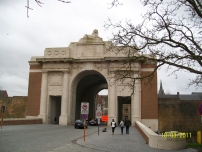| First Name: | Cyril Gervase | Last Name: | SEATON | |
|---|---|---|---|---|
| Date of Death: | 01/11/1914 | Lived/Born In: | Blackheath | |
| Rank: | Private | Unit: | London14 | |
| Memorial Site: | 1. Charlton Memorial 2. Menin Gate, Ypres | |||
Current Information:Age-36 Enlisted-London
The Race to the Sea - September-October 1914 By the middle of September 1914, the Aisne battlefield had stagnated into trench warfare and in order to break this impasse, both sides tried to outflank each other in a general movement northwards. Moving up through Picardy, Artois & Flanders, the race was over by 19th October when the North Sea was reached. The Western Front, a line of trenches stretching from Belgium to Switzerland, was now a reality. Initially it was the French army that conducted this movement whilst the British Expeditionary Force remained on the Aisne but by 6 October British reinforcements were needed to help beat off German attacks around Lille. They moved north and along with reinforcements from Britain, they took up new positions in Flanders, on the left of the Allied line and much closer to the Channel ports. The Battle of Messines - 12th October-2nd November 1914 The Battle of Messines was one of the actions that took place during the Race to the Sea and it took place between the Comines-Ypres canal and the River Douvre. It involved the 1st and 2nd Cavalry Divisions and elements of the 3rd, 4th and 5th Divisions as well part of the Indian Division. In the early morning of 31st October, there was a strong German attack at Messines and just further to the north at Wytschaete. The 14th London (London Scottish) battalion of 1 Brigade, 1st Division, were sent from St Eloi to support the hard pressed cavalry units there. Making their way along the back of the Messines ridge from Wytschaete they were ordered to reinforce the cavalry holding the ridge east of the main road between Messines and Wytschaete. They advanced in an attack formation rather than dribbling up reinforcements and as they were seen by the Germans, they were heavily shelled. Their right reached 4 Cavalry Brigade’s trenches and their left, though badly enfiladed, got even further forward and engaged the German infantry. They remained in makeshift trenches and often in exposed conditions until the line was reorganised at night. Meanwhile the reserve company of 14th London were deployed on the left to counter the enemy who were threatening Wytschaete. At the 1 a.m on 1st November there was a general German attack against Messines ridge on the sector held by 6th Dragoon Guards and 14th London between the windmill three quarters of a mile north of Messines, and Wytschaete. British fire was steady but again weight of numbers was most telling. The Germans infiltrated the open ridge but the timely charge by the reserve company of 14th London together with the resistance of one squadron in particular of the 6th Dragoon Guards, enabled possession of the ridge to be maintained. At 9 am, because the British had been driven off the Messines Ridge a general withdrawal to the next ridge, half a mile east of Wulverghem, was ordered and the remnants of 14th London, dug in on Wulverghem ridge to cover this movement. 14th London were the first territorial unit in action in the the war and to add to their problems at Messines the bullets they had been issued with were incompatible with their rifles and had to be loaded singly. The battalion suffered many casualties during their first action, one of whom was Cyril Seaton. |
||||
| « Back to Search Results | ||||
| If you think any of the information shown here is incorrect, Click Here to submit your amends and comments | ||||




